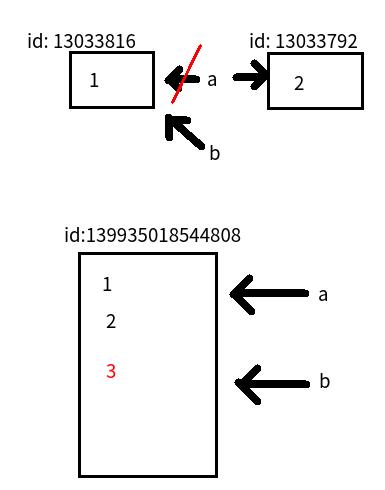python简单学------------公共方法,引用等
Posted sucfrperperseverance
tags:
篇首语:本文由小常识网(cha138.com)小编为大家整理,主要介绍了python简单学------------公共方法,引用等相关的知识,希望对你有一定的参考价值。
公共方法
运算符
| 运算符 | Python 表达式 | 结果 | 描述 | 支持的数据类型 |
|---|---|---|---|---|
| + | [1, 2] + [3, 4] | [1, 2, 3, 4] | 合并 | 字符串、列表、元组 |
| * | \'Hi!\' * 4 | [\'Hi!\', \'Hi!\', \'Hi!\', \'Hi!\'] | 复制 | 字符串、列表、元组 |
| in | 3 in (1, 2, 3) | True | 元素是否存在 | 字符串、列表、元组、字典 |
| not in | 4 not in (1, 2, 3) | True | 元素是否不存在 | 字符串、列表、元组、字典 |
+
>>> "hello " + "itcast"
\'hello itcast\'
>>> [1, 2] + [3, 4]
[1, 2, 3, 4]
>>> (\'a\', \'b\') + (\'c\', \'d\')
(\'a\', \'b\', \'c\', \'d\')
*
>>> \'ab\'*4
\'ababab\'
>>> [1, 2]*4
[1, 2, 1, 2, 1, 2, 1, 2]
>>> (\'a\', \'b\')*4
(\'a\', \'b\', \'a\', \'b\', \'a\', \'b\', \'a\', \'b\')
in
>>> \'itc\' in \'hello itcast\'
True
>>> 3 in [1, 2]
False
>>> 4 in (1, 2, 3, 4)
True
>>> "name" in {"name":"Delron", "age":24}
True
注意,in在对字典操作时,判断的是字典的键
python内置函数
Python包含了以下内置函数
| 序号 | 方法 | 描述 |
|---|---|---|
| 1 | cmp(item1, item2) | 比较两个值 |
| 2 | len(item) | 计算容器中元素个数 |
| 3 | max(item) | 返回容器中元素最大值 |
| 4 | min(item) | 返回容器中元素最小值 |
| 5 | del(item) | 删除变量 |
cmp
>>> cmp("hello", "itcast")
-1
>>> cmp("itcast", "hello")
1
>>> cmp("itcast", "itcast")
0
>>> cmp([1, 2], [3, 4])
-1
>>> cmp([1, 2], [1, 1])
1
>>> cmp([1, 2], [1, 2, 3])
-1
>>> cmp({"a":1}, {"b":1})
-1
>>> cmp({"a":2}, {"a":1})
1
>>> cmp({"a":2}, {"a":2, "b":1})
-1
注意:cmp在比较字典数据时,先比较键,再比较值。
len
>>> len("hello itcast")
12
>>> len([1, 2, 3, 4])
4
>>> len((3,4))
2
>>> len({"a":1, "b":2})
2
注意:len在操作字典数据时,返回的是键值对个数。
max
>>> max("hello itcast")
\'t\'
>>> max([1,4,522,3,4])
522
>>> max({"a":1, "b":2})
\'b\'
>>> max({"a":10, "b":2})
\'b\'
>>> max({"c":10, "b":2})
\'c\'
del
del有两种用法,一种是del加空格,另一种是del()
>>> a = 1
>>> a
1
>>> del a
>>> a
Traceback (most recent call last):
File "<stdin>", line 1, in <module>
NameError: name \'a\' is not defined
>>> a = [\'a\', \'b\']
>>> del a[0]
>>> a
[\'b\']
>>> del(a)
>>> a
Traceback (most recent call last):
File "<stdin>", line 1, in <module>
NameError: name \'a\' is not defined
多维列表/元祖访问的示例
>>> tuple1 = [(2,3),(4,5)]
>>> tuple1[0]
(2, 3)
>>> tuple1[0][0]
2
>>> tuple1[0][2]
Traceback (most recent call last):
File "<stdin>", line 1, in <module>
IndexError: tuple index out of range
>>> tuple1[0][1]
3
>>> tuple1[2][2]
Traceback (most recent call last):
File "<stdin>", line 1, in <module>
IndexError: list index out of range
>>> tuple2 = tuple1+[(3)]
>>> tuple2
[(2, 3), (4, 5), 3]
>>> tuple2[2]
3
>>> tuple2[2][0]
Traceback (most recent call last):
File "<stdin>", line 1, in <module>
TypeError: \'int\' object is not subscriptable
引用
想一想
>>> a = 1
>>> b = a
>>> b
1
>>> a = 2
>>> a
2
请问此时b的值为多少?
>>> a = [1, 2]
>>> b = a
>>> b
[1, 2]
>>> a.append(3)
>>> a
[1, 2, 3]
请问此时b的值又是多少?
引用
在python中,值是靠引用来传递来的。
我们可以用id()来判断两个变量是否为同一个值的引用。 我们可以将id值理解为那块内存的地址标示。
>>> a = 1
>>> b = a
>>> id(a)
13033816
>>> id(b) # 注意两个变量的id值相同
13033816
>>> a = 2
>>> id(a) # 注意a的id值已经变了
13033792
>>> id(b) # b的id值依旧
13033816
>>> a = [1, 2]
>>> b = a
>>> id(a)
139935018544808
>>> id(b)
139935018544808
>>> a.append(3)
>>> a
[1, 2, 3]
>>> id(a)
139935018544808
>>> id(b) # 注意a与b始终指向同一个地址
139935018544808

可变类型与不可变类型
可变类型,值可以改变:
- 列表 list
- 字典 dict
不可变类型,值不可以改变:
- 数值类型 int, long, bool, float
- 字符串 str
- 元组 tuple
注意可变类型与不可变类型,可变类型为值发生变化,引用id(地址)不发生变化,不可变类型为值发生变化,引用id(地址)发生变化
怎样交换两个变量的值?
a,b=b,a
以上是关于python简单学------------公共方法,引用等的主要内容,如果未能解决你的问题,请参考以下文章